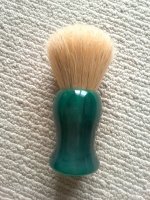Another thread was going off topic so I started this one.
"That makes a lot of sense. Omega boars seem to be like brooms and Semogue like mops. Brooms push and distribute. Mops soak in, hold and smear." @naughtilus
"Exactly, very good example. It's the only explanation i could think of. Because when i started buying Semogues, i was dumbfounded, because i was loading them as i was used to load boars, but i was constantly running out of lahter. And i have been a boar user for many years, it's not like i hadn't seen a boar before. They were just behaving very differently compared to Omegas." @Boar Fighter
People were pointing out the difference in these boar brushes and I wonder what it is that makes the bristles so different. Is it a different animal, a different part of the animal, or a different treatment done to the bristles?
These brushes behave so differently, maybe we shouldn't be lumping boar brushes together as much as we do.
"That makes a lot of sense. Omega boars seem to be like brooms and Semogue like mops. Brooms push and distribute. Mops soak in, hold and smear." @naughtilus
"Exactly, very good example. It's the only explanation i could think of. Because when i started buying Semogues, i was dumbfounded, because i was loading them as i was used to load boars, but i was constantly running out of lahter. And i have been a boar user for many years, it's not like i hadn't seen a boar before. They were just behaving very differently compared to Omegas." @Boar Fighter
People were pointing out the difference in these boar brushes and I wonder what it is that makes the bristles so different. Is it a different animal, a different part of the animal, or a different treatment done to the bristles?
These brushes behave so differently, maybe we shouldn't be lumping boar brushes together as much as we do.
Last edited:




